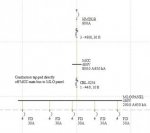EEDude
Member
- Location
- Spfld Area, MA
Hi folks...
This is my first post so please forgive if this has been covered. I did look but came up short...
Rather than try to explain here's a pic of what I was looking at. I believe the 10' tap rule covers both of these applications? Just looking for a little affirmation.
For Fig A, switch gear has no main and is close coupled to the transformer.
Fig B is a tap directly off of an MCC bus (10' or less in conduit) to a MLO panelboard.
Hopefully, between my brief explaination and the figures it will be clear.
Looking for code references and interpretations....
What confuses me, is the "can't tap a tap" rule. Technically these branch breakers are not taps. Correct?
Thanks so much in advance.
Fig A

Fig B

This is my first post so please forgive if this has been covered. I did look but came up short...
Rather than try to explain here's a pic of what I was looking at. I believe the 10' tap rule covers both of these applications? Just looking for a little affirmation.
For Fig A, switch gear has no main and is close coupled to the transformer.
Fig B is a tap directly off of an MCC bus (10' or less in conduit) to a MLO panelboard.
Hopefully, between my brief explaination and the figures it will be clear.
Looking for code references and interpretations....
What confuses me, is the "can't tap a tap" rule. Technically these branch breakers are not taps. Correct?
Thanks so much in advance.
Fig A

Fig B


